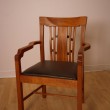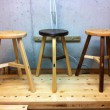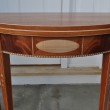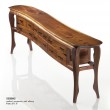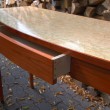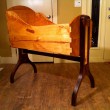Beginner, Intermediate or Advanced? Who Cares!
Article - September 5, 2013
In my opinion, classifying woodworking projects by skill level is a mistake. Since I publish woodworking project plans and videos in the Guild, I often receive emails asking me why I don’t specify whether a project is Beginner, Intermediate, or Advanced. There’s a very good reason for it, which we’ll get to in a minute. You’ll also notice that our Viewer Project Gallery makes no mention of difficulty level. Instead, we simply list the number of years the person has been woodworking. We’ve all seen these traditional skill level classifications in magazines, project plans, and woodworking classes and as a result some folks don’t know how to gauge the appropriateness of a project without the label.
These classifications have a couple critical flaws. First, they depend heavily on our ability to self-identify with one group or another. Since there are no tests or regulations on woodworking skill levels, it’s pretty much a crapshoot and most of us simply make our best guess. Even if you consider yourself an Intermediate woodworker, how often have you found new woodworkers or non-woodworkers absolutely blown away by your “advanced” skill level? Depending on the perspective, you may or may not view your own skill level clearly. Second, even if you manage to rate your own skill with some level of accuracy, that doesn’t mean the people producing the plans/classes rate skill level on the same scale as you. There is no official published protocol for this stuff and most times the publisher is making their best guess. To make matters worse, did you ever notice that skill levels differ based on the intended audience? Is it fair to say that Fine Woodworking’s intermediate projects might be considered advanced in WOOD Magazine? Wonderful! Now I need a chart for woodworking publication skill level conversion rates!! Obviously I’m having a little fun here in an attempt to illustrate a point.
I think we would all look at a face grain cutting board and classify it as a beginner project, right? We might also look at a Philadelphia Chippendale Highboy and call it advanced. But what about everything in between? The giant mass of projects that fall somewhere between extreme beginner and extreme advanced represents a gray area that is nearly impossible to classify meaningfully and consistently.
Why do I care? Because I find these mostly meaningless classifications to be potentially limiting and discouraging. Most beginners will shy away from intermediate and advanced projects simply because they assume they just aren’t ready for them. After 5 years, they might still consider themselves a beginner and haven’t yet progressed beyond napkin holders and bird houses (not that there’s anything wrong with those projects). But if the woodworker’s goal is to become a highly-skilled craftsperson, he/she should intentionally take on projects that are beyond their current perceived skill level. Will they make mistakes? Yes. Will they need to make a couple parts more than once? Probably. Will they learn at an exponential rate because of these mistakes? You bet! One of the best ways to avoid mistakes is to experience the heartache of making them! Conversely, there is no better way to slow your progress than to do the woodworking equivalent of treading water: only working projects you already contain the skills to create.
I came to this conclusion during my first teaching gig at the William Ng School several years ago. Each class I teach attracts woodworkers with a wide variety of skill levels. That’s just how things go at woodworking schools. But I didn’t necessarily expect there to be a complete newbie in the class. One of my students was a busy LA professional who decided to take a woodworking class just to blow off some steam. He had absolutely no experience yet hoped to build a complex piece of furniture within five days. I had my doubts, but since I’m always up for a challenge I dove right in. I gave the guy extra attention where needed, especially as it concerned safety and using various tools for the first time, but other than that he was treated the same as everyone else and I certainly didn’t do any of the work for him. By the end of the five days, this “non-woodworker” was the first one finished and he made the fewest mistakes. He was given a series of steps and the tools to accomplish them and rose to the occasion. My mind was thoroughly blown. Since then, every class I teach at the William Ng School seems to have that same scenario with at least one person completely new to the craft. I am always delighted to work with them because they are usually full of pleasant surprises.
More recently, and in greater numbers, my experience with my fellow Wood Whisperer Guild members has reinforced my viewpoint. Time and time again a completely new or relatively new woodworker comes in and knocks out what I consider to be one of our more advanced projects. I can’t tell you how many “wet under the wings” woodworkers have built classic Guild projects like the Split-Top Roubo and the G&G Adirondack Chair. You can see some of them in our Guild Gallery if you are interested.
I recently emailed the Guild and asked them to send me pictures of their first or near-first projects. I wanted to see what these talented and energetic people were capable of building while most considered them beginners. I received over 80 submissions within two days! Obviously I can’t include them all here but I did pick some of my favorites. A big fat thank you to everyone who submitted a project and I truly regret not being able to showcase them all.
Check out some of these projects built by Guild members when they were very new to the craft. Each one of these projects was either a first or second project with the maker having 0-2 yrs experience:
Allen Grant, Chris, David, Dustin, Greg
Jalen Waggoner, Josh, Justin, Kerry, Marilyn Guthrie
Paul, Riley, Robert, Roger, Scott
Tim, Tom Buhl, Vic Hubbard
As you can see, even a beginner can produce fairly high level work. Would these woodworkers have been better off if they set their sights lower and focused only on projects appropriate for their noobness? I think not! Instead, they tackled projects that required them to think, practice, and improve. Well done my friends!
The intention of this project showcase is to inspire. I really don’t want anyone who might not have progressed as quickly as these folks to feel that they are somehow behind the curve. Each one of us is on our own personal woodworking journey and we all need to work at our own pace and comfort level. But I do encourage you to constantly challenge yourself. Progress as fast as YOU can, not as fast as other people can. In other words, bring your personal best to every project and you will get better quickly.
With the proper guidance and the right tools, no project is out of your reach! Take all skill level ratings with a grain of salt and instead of fixating on Beginner, Intermediate, or Advanced, examine the project itself and the skills, tools, and techniques required to make it in order to determine if it’s right for you. And if you are a lifetime student of the craft, you’ll nearly always choose projects that contain elements you don’t currently know how to accomplish. You don’t want to necessarily bite off more than you can chew but you should always have a good substantial mouthful.





